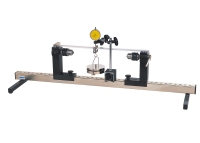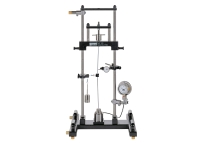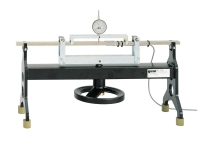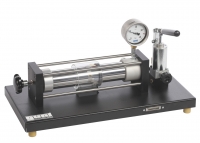Strength of materials
Strength of materials deals with the effect of forces on deformable bodies. In addition, material-dependent parameters should be considered as well. An introduction to the strength of materials is, therefore, given by the concept of stress and strain and by Hooke’s law, which is applied to tension, pressure, torsion and bending problems.
The load from external forces causes stresses in the components. The mesh of the material is deformed under the action of a force, e.g. compressed, stretched etc. Elastic deformation means the atoms return to their original position after the action of the force has ceased.

Demonstration of Maxwell-Betti theorem
Learning objectives/experiments
- elastic line under varying load
- elastic line under various support conditions
- demonstration of Maxwell–Betti’s theorem
- elastic line in statically indeterminate systems

Elastic lines of statically determinate and indeterminate beams under various clamping conditions
Learning objectives/experiments
- investigation of the deflection for statically determinate and statically indeterminate straight beams
- cantilever beam
- single-span beam, dual- or triple-span beam
- formulation of the differential equation for the elastic line
- deflection on a cantilever beam
….

Determination of elastic lines of a beam under load using the principle of virtual work and Mohr's analogy
Learning objectives/experiments
- elastic lines for statically determinate or indeterminate beams under load
- determination of the elastic line of a beam by
- the principle of virtual work (calculation)
- Mohr’s analogy (area moment method devised by Mohr; graphical representation)
- application of the principle of superposition
….

Investigation of elastic torsion of bars with open and closed cross-section
Learning objectives/experiments
- torsion of a bar
- shear modulus of elasticity and second polar moment of area
- angle of twist dependent on clamping length
- angle of twist dependent on torque
- influence of rigidity on torsion
….

Influence of material, cross-section and clamping length on deformation
Learning objectives/experiments
- bending tests
- determination of the modulus of elasticity
- statically determinate systems (beam mounted on two supports; cantilever beam)
- statically indeterminate systems (dual-span beam)
- deformation of a beam dependent on material, geometry (section width, height and length), type of support and length of span
….

Elastic deformation of a statically determinate or indeterminate frame under point load
Learning objectives/experiments
- relationship between load application and deformation on the frame
- differences between statically determinate and statically indeterminate frames
- familiarisation with the first-order elasticity theory for statically determinate and indeterminate systems
- application of the principle of superposition
- application of the principle of virtual work on statically determinate and statically indeterminate frames
….

Principle of virtual forces (the force method) for calculating deformation
Learning objectives/experiments
- bending behaviour of a curved-axis beam
- circular beam
- semi-circular beam
- quadrant beam
- application of the principle of virtual forces (the force method) to calculate deformation
….

Application of Castigliano’s first theorem
Learning objectives/experiments
- elastic deformation of truss under point load
- calculation of support reaction and bar forces
- principle of work and strain energy
- application of Castigliano’s first theorem to calculate the deformation at a defined point
- verification of the calculated deformation possible by the principle of virtual work
….

Measurement of bar forces; comparison of forces in statically determinate and statically indeterminate trusses
Learning objectives/experiments
- measurement of the bar forces in a statically determinate and statically indeterminate plane truss
- dependence of the bar forces on the external force
- quantity, direction, point of application
- measurement and determination of support reactions
- comparison of theory and practice: comparison of measurement results with mathematical solution methods
….

Demonstration of the resulting characteristics of the contact area as a function of the contact force
Learning objectives/experiments
- resulting shape of the contact area under point contact with different radii of curvature
- shape of the contact area as a function of the contact force
- influence of an additional transverse component of the contact force

Elastic behaviour of tension springs under load
Learning objectives/experiments
- investigation of the proportionality of the active force and the spring deflection
- determination of the spring constant
- series configuration of two tension springs
- investigation of the influence of the spring constant on the frequency of a spring-mass system
Long and slender components such as rods, beams, supports etc. may end up in indifferent or unstable equilibrium states and buckle if they are exposed to a force along the rod axis under compressive stress. The mathematician and physicist Leonhard Euler defined four typical buckling cases to calculate the buckling force in rods.

Determination of the buckling load under different conditions
Learning objectives/experiments
- determination of the buckling force for the case of an:
- elastic joint
- elastic fixed end support
- investigation of the buckling behaviour under the influence of:
- of additional shear forces
….
- of additional shear forces

Determination of the buckling load: influence of material, support, and shear force
Learning objectives/experiments
- investigation of buckling behaviour under the influence of
- different supports, clamps
- different cross-sections
- different materials
- additional shear forces
….

Verification of the Euler theory of buckling: influence of material, cross-section, length, and support
Learning objectives/experiments
- investigation of buckling behaviour under the influence of
- different supports and clamps
- different bar lengths and cross-sections
- different materials
- additional lateral load
….

Correlation between buckling length, buckling load and various methods of support
Learning objectives/experiments
- demonstration of various buckling problems
- Euler case 1 – fixed-free bar
- Euler case 2 – pinned-pinned bar
- Euler case 3 – fixed-pinned bar
- Euler case 4 – fixed-fixed bar
….
Experimental equipment to investigate components in which two or more basic stresses are present simultaneously.

Investigation of symmetrical and unsymmetrical bending on a beam. Combined bending and torsion loading using an eccentric force.
Learning objectives/experiments
- product moment of inertia (Iyz) and axial second moment of area (Iy, Iz)
- Bernoulli hypothesis
- symmetrical bending on a beam (uniaxial)
- with I-profile
- with L-profile
….

Multiaxial loading of samples by bending and torsion
Learning objectives/experiments
- generation of multi-axial loads on test samples made of ductile metals:
- steel, copper, brass, aluminium
- generation of various load moments
- pure bending moment
- pure twisting moment
….
Two methods of non-destructive experimental stress and strain analysis are presented here:
- the electrical method of strain measurement using strain gauges to indirectly determine the actual stresses
- the photoelastic method for a direct representation of the stress distribution

Basic introduction to measurement with strain gauges for tension, bending and torsion
Learning objectives/experiments
- fundamentals of measuring with strain gauges
- strain gauge types and application techniques
- calculation of the mechanical deformations under tension, bending and torsion
- correlation between mechanical strain and electrical resistance in a strain gauge
- with FL 100.01, FL 100.02, FL 100.03: determination of the modulus of elasticity for various materials from the measuring data of a tensile test

Complete equipment for practising manual handling of strain gauge technology
Learning objectives/experiments
- fundamentals of electrical resistance strain gauges
- preparation of the measuring point
- selection of a suitable strain gauge
- attaching, wiring up and configuring strain gauges on mechanically stressed components
- protection of the strain gauge measuring point against external influences
….

Calibration of a strain gauge: measurement of deflection and strain
Learning objectives/experiments
- fundamentals of measurement using strain gauges
- measurement of deflection using a dial gauge
- determination of the gauge factor of strain gauges

Investigation of deflection and strain of a membrane under internal pressure; membrane with strain gauge application
Learning objectives/experiments
- measure radial and tangential strain using strain gauges
- measure deflection using a dial gauge
- calculate the stresses from the measured strains: radial stress, tangential stress
- determine direction of principal stress
- application of Mohr’s strain circle to determine the principal strains
….

Investigation of axial and circumferential stress in a thin-walled cylinder under internal pressure
Learning objectives/experiments
- measure strains with strain gauges
- application of Mohr’s stress circle to determine the principal strain
- determine the principal stresses: axial and circumferential stresses by magnitude and direction
- in an open vessel (pipe)
- in a closed vessel (boiler)
….

Triaxial stress state in the cylinder wall; cylinder with strain gauge application on surface and in wall
Learning objectives/experiments
- measurement of elongations by strain gauges
- application of Mohr’s circle for the triaxial stress state
- determination of the distribution of direct stress in
- radial, tangential and axial direction
- investigation of correlations between elongation, pressure and stress in the triaxial stress state

Processing of analogue measuring signals for stress and strain analysis FL 120 - FL 140 and for GUNT trusses
Learning objectives/experiments
- amplification and display of signals from strain gauge measuring points
- processing of measured values on computer
- evaluation of stress and strain analysis experiments, in conjunction with: FL 120, FL 130, FL 140
- evaluation of experiments relating to forces in trusses, in conjunction with: SE 130, SE 110.21, SE 110.22

Visualisation of mechanical stresses in models subject to varying loads
Learning objectives/experiments
- together with the accessories or your own models:
- generate plane stress states in various models under load: bending, tensile load and compressive load
- investigate stress distributions with linear or circular polarised light
- interpret photoelastic fringe patterns: stress concentrations, zero points, neutral strands, areas of constant stress and stress gradients
- graphically and computationally determine the stresses

Representation of distribution of stress and stress concentrations in component models. Can be used in conjunction with an overhead projector.
Learning objectives/experiments
- generate plane stress states in various models under load
- compressive load
- tensile load
- investigate stress distributions with linear and circular polarised light
- interpret photoelastic fringe patterns
….







